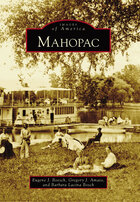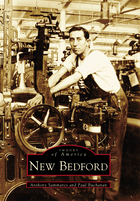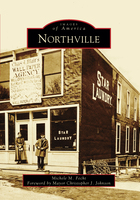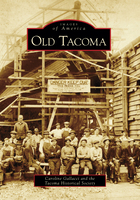Browse Titles - 77 results
5. The Jell-O Story
written by Lynne J. Belluscio; in LeRoy, Images of America (Charleston, SC: Arcadia Publishing), 71-80
LeRoy is best known as the "Birthplace of Jell-O," but few people know that in 1929 it had one of the finest private airports in the United States and was home to Amelia Earhart's airplane, the Friendship. In the 19th century, LeRoy was known for Igham University, one of the first colleges for women and the first...
Sample
written by Lynne J. Belluscio; in LeRoy, Images of America (Charleston, SC: Arcadia Publishing), 71-80
Description
LeRoy is best known as the "Birthplace of Jell-O," but few people know that in 1929 it had one of the finest private airports in the United States and was home to Amelia Earhart's airplane, the Friendship. In the 19th century, LeRoy was known for Igham University, one of the first colleges for women and the first to grant a four-year degree. First settled in 1797, LeRoy has produced patent medicines, salt, limestone, dynamite, plows, agricultural...
LeRoy is best known as the "Birthplace of Jell-O," but few people know that in 1929 it had one of the finest private airports in the United States and was home to Amelia Earhart's airplane, the Friendship. In the 19th century, LeRoy was known for Igham University, one of the first colleges for women and the first to grant a four-year degree. First settled in 1797, LeRoy has produced patent medicines, salt, limestone, dynamite, plows, agricultural commodities, stoves, organs, insulators, and a myriad of other products. Located on the eastern edge of Genesee County and 30 miles southwest of Rochester, LeRoy originally depended on water power from the Oatka Creek and was soon serviced by several railroads. It was also a station on the Underground Railroad.
Show more
Show less
Field of Study
American History
Content Type
Book
Author / Creator
Lynne J. Belluscio
Publisher
Arcadia Publishing
Series
Images of America
Topic / Theme
Food industry
Copyright Message
Copyright © 2010 by Lynne J. Belluscio
×
5. Mahopac Falls and Red Mills
written by Eugene J. Boesch, Gregory J. Amato and Barbara Lacina Bosch; in Mahopac, Images of America (Charleston, SC: Arcadia Publishing), 41-48
Mahopac's first known colonial settlement was founded near the large lake bearing the Algonquian name "Macookpack" around 1740. During the American Revolution, the area served as an important logistical center and supply depot for the American cause. Following the war, the hamlet developed into an agricultural bre...
Sample
written by Eugene J. Boesch, Gregory J. Amato and Barbara Lacina Bosch; in Mahopac, Images of America (Charleston, SC: Arcadia Publishing), 41-48
Description
Mahopac's first known colonial settlement was founded near the large lake bearing the Algonquian name "Macookpack" around 1740. During the American Revolution, the area served as an important logistical center and supply depot for the American cause. Following the war, the hamlet developed into an agricultural breadbasket, supplying goods and produce—especially dairy items—region-wide. By the mid-19th century, Mahopac, particularly its grand...
Mahopac's first known colonial settlement was founded near the large lake bearing the Algonquian name "Macookpack" around 1740. During the American Revolution, the area served as an important logistical center and supply depot for the American cause. Following the war, the hamlet developed into an agricultural breadbasket, supplying goods and produce—especially dairy items—region-wide. By the mid-19th century, Mahopac, particularly its grand lake, became a resort destination with many large hotels and boardinghouses. Arrival of the railroad to Mahopac in 1872 further supported tourism in the lakeside resorts as travelers from New York City could now reach Lake Mahopac within a few hours. Drawing from the archives of the Carmel Historical Society, Putnam County Historian's Office, and the collections of the authors and others, Mahopac depicts daily life during the community's bygone eras.
Show more
Show less
Field of Study
American History
Content Type
Book
Author / Creator
Eugene J. Boesch, Gregory J. Amato, Barbara Lacina Bosch
Publisher
Arcadia Publishing
Series
Images of America
Topic / Theme
Grist mills, Waterfalls, Town life
Copyright Message
Copyright © 2012 by Eugene J. Boesch, Gregory J. Amato, and Barbara Lacina Bosch
×
3. Mills
written by Dennis McDonald; in Medford, Images of America (Charleston, SC: Arcadia Publishing), 61-68
Settled by Quakers in the late 1600s, Medford was dominated by sawmills and gristmills in the mid-1700s. During the 1800s, small Quaker and public schools were scattered throughout the township, three of which still survive today. When Medford became a town in 1847, after breaking away from Evesham, it had already...
Sample
written by Dennis McDonald; in Medford, Images of America (Charleston, SC: Arcadia Publishing), 61-68
Description
Settled by Quakers in the late 1600s, Medford was dominated by sawmills and gristmills in the mid-1700s. During the 1800s, small Quaker and public schools were scattered throughout the township, three of which still survive today. When Medford became a town in 1847, after breaking away from Evesham, it had already begun to develop as a community. William Cooper, a photographer during the turn of the 20th century, captured many of the images featu...
Settled by Quakers in the late 1600s, Medford was dominated by sawmills and gristmills in the mid-1700s. During the 1800s, small Quaker and public schools were scattered throughout the township, three of which still survive today. When Medford became a town in 1847, after breaking away from Evesham, it had already begun to develop as a community. William Cooper, a photographer during the turn of the 20th century, captured many of the images featured in Medford. Cooper photographed workers at Kirby's Mill loading wagons, baseball players at the Medford Field Club, schoolchildren at Cross Keys School, employees at Braddock's Tavern, staff at the Indian Chief Hotel, glass blowers turning out bottles at Star Glass Company, and travelers at the Philadelphia, Marlton, and Medford train station on Main Street. He also snapped pictures of parades, kids playing in the streets, and men playing craps.
Show more
Show less
Field of Study
American History
Content Type
Book
Author / Creator
Dennis McDonald
Publisher
Arcadia Publishing
Series
Images of America
Topic / Theme
Grist mills
Copyright Message
Copyright © 2012 by Dennis McDonald
×
2. Mills, Factories, and Businesses
written by Grace G. Hoag and Priscilla N. Howker; in Medway, Images of America (Charleston, SC: Arcadia Publishing, 2004), 21-44
Sample
written by Grace G. Hoag and Priscilla N. Howker; in Medway, Images of America (Charleston, SC: Arcadia Publishing, 2004), 21-44
Field of Study
American History
Content Type
Book
Author / Creator
Grace G. Hoag, Priscilla N. Howker
Date Published / Released
2004
Publisher
Arcadia Publishing
Series
Images of America
Topic / Theme
Business, Factories, Grist mills, Lumber mills
Copyright Message
Copyright © 2004 by Grace G. Hoag and Priscilla N. Howker
×
6. From Creamery to City Hall
written by Frank Thomason and Polly Ambrose Peterson; in Meridian, Images of America (Charleston, SC: Arcadia Publishing, 2009), 103-114
Eight miles west of Idaho's capital city, Boise, the first settlers in what became Meridian found only arid land, sagebrush, and jackrabbits. The lone tree in the area was another 8 miles west in what became Nampa. Originally called Hunter, after a railroad superintendent, Meridian was initially a railway postal d...
Sample
written by Frank Thomason and Polly Ambrose Peterson; in Meridian, Images of America (Charleston, SC: Arcadia Publishing, 2009), 103-114
Description
Eight miles west of Idaho's capital city, Boise, the first settlers in what became Meridian found only arid land, sagebrush, and jackrabbits. The lone tree in the area was another 8 miles west in what became Nampa. Originally called Hunter, after a railroad superintendent, Meridian was initially a railway postal drop where workers tossed and hooked mailbags as the train passed through before the arrival of passenger service. By 1893, residents ca...
Eight miles west of Idaho's capital city, Boise, the first settlers in what became Meridian found only arid land, sagebrush, and jackrabbits. The lone tree in the area was another 8 miles west in what became Nampa. Originally called Hunter, after a railroad superintendent, Meridian was initially a railway postal drop where workers tossed and hooked mailbags as the train passed through before the arrival of passenger service. By 1893, residents called the village Meridian, after the north-south prime meridian running through Meridian Road. In 1903, the village incorporated but still had a population of only a few hundred with grocery and harness shops and more churches than saloons. Village merchants and residents experienced orchard and dairy/creamery eras that ended in, respectively, the 1940s and 1970. Meridian became a city in the 1940s but 50 years later had a population of only 10,000. That number quadrupled over the next decade and today has nearly doubled again to around 80,000, as Meridian has evolved into the transportation and commercial hub of the Treasure Valley, especially in electronics and health care.
Show more
Show less
Field of Study
American History
Content Type
Book
Author / Creator
Frank Thomason, Polly Ambrose Peterson
Date Published / Released
2009
Publisher
Arcadia Publishing
Series
Images of America
Topic / Theme
Dairy products, Cattle, Food industry, Community events, Persons, Great Depression, 1929-1941
Copyright Message
Copyright © 2010 by Frank Thomason and Polly Ambrose Peterson
×
5. Flour Mill, River, and Lake
written by Martha A. Churchill; in Milan, Images of America (Charleston, SC: Arcadia Publishing), 83-92
John Marvin started the town of Milan in 1831 by placing a two-story log building beside a dirt Native American trail. The Saline River was just a few steps away. About that time, Native Americans were either moving to reservations west of Michigan or blending in with the melting pot. Milan and its neighboring com...
Sample
written by Martha A. Churchill; in Milan, Images of America (Charleston, SC: Arcadia Publishing), 83-92
Description
John Marvin started the town of Milan in 1831 by placing a two-story log building beside a dirt Native American trail. The Saline River was just a few steps away. About that time, Native Americans were either moving to reservations west of Michigan or blending in with the melting pot. Milan and its neighboring communities, such as Azalia, Paint Creek, and Mooreville, grew quickly with the influx of settlers from out East. Shoemakers arrived, alon...
John Marvin started the town of Milan in 1831 by placing a two-story log building beside a dirt Native American trail. The Saline River was just a few steps away. About that time, Native Americans were either moving to reservations west of Michigan or blending in with the melting pot. Milan and its neighboring communities, such as Azalia, Paint Creek, and Mooreville, grew quickly with the influx of settlers from out East. Shoemakers arrived, along with grocers, flour mills, and even cheese factories. The Milan Area Historical Society holds a treasure trove of photographs, maps, and drawings showing the heritage in and around Milan. One of its citizens was nationally known for his scale inventions. Other citizens achieved notoriety for pulling off a stock scam in New York promoting the Electric Sugar Refining Company. Two magnificent homes near Milan were built with "sugar money."
Show more
Show less
Field of Study
American History
Content Type
Book
Author / Creator
Martha A. Churchill
Publisher
Arcadia Publishing
Series
Images of America
Topic / Theme
Rivers, Grist mills, Lakes
Copyright Message
Copyright © 2009 by Martha A. Churchill
×
Images of America, Montgomery County
in Images of America (Charleston, SC: Arcadia Publishing, 2004), 128 page(s),
Source: www.arcadiapublishing.com
Source: www.arcadiapublishing.com
With a rich and varied history spanning almost three hundred years, Montgomery County suffered during the Revolutionary War, prospered with the Erie Canal and the railroad, and changed in the age of urban renewal. Located in the heart of the Mohawk Valley in upstate New York, the county experienced the arrival of...
Sample
in Images of America (Charleston, SC: Arcadia Publishing, 2004), 128 page(s),
Source: www.arcadiapublishing.com
Source: www.arcadiapublishing.com
Description
With a rich and varied history spanning almost three hundred years, Montgomery County suffered during the Revolutionary War, prospered with the Erie Canal and the railroad, and changed in the age of urban renewal. Located in the heart of the Mohawk Valley in upstate New York, the county experienced the arrival of Dutch and Palatine German settlers, the passage of travelers heading west through the Noses, the pre-suffragist sojourn of Susan B. Ant...
With a rich and varied history spanning almost three hundred years, Montgomery County suffered during the Revolutionary War, prospered with the Erie Canal and the railroad, and changed in the age of urban renewal. Located in the heart of the Mohawk Valley in upstate New York, the county experienced the arrival of Dutch and Palatine German settlers, the passage of travelers heading west through the Noses, the pre-suffragist sojourn of Susan B. Anthony, and the swift success of the carpet industry. All of this is compellingly retold in Montgomery County, a broad look at the people, industry, culture, and architecture that make up the county’s history.
Show more
Show less
Field of Study
American History
Content Type
Book
Date Published / Released
2004
Publisher
Arcadia Publishing
Series
Images of America
Copyright Message
Copyright © 2004 by Kelly Yacobucci Farquhar
Sections
×
7. Whaling
written by Anthony Mitchell Sammarco and Paul Buchanan, 1956-; in New Bedford, Images of America (Charleston, SC: Arcadia Publishing, 2003), 81-98
In 1765, when Joseph Rotch sailed across the bay from Nantucket, he brought with him the skills and knowledge to start New Bedford's whaling industry. By 1830 the town was a larger whaling port than Nantucket, with an immense fleet employing more than 10,000 people.
Sample
written by Anthony Mitchell Sammarco and Paul Buchanan, 1956-; in New Bedford, Images of America (Charleston, SC: Arcadia Publishing, 2003), 81-98
Description
In 1765, when Joseph Rotch sailed across the bay from Nantucket, he brought with him the skills and knowledge to start New Bedford's whaling industry. By 1830 the town was a larger whaling port than Nantucket, with an immense fleet employing more than 10,000 people.
Field of Study
American History
Content Type
Book
Author / Creator
Anthony Mitchell Sammarco, Paul Buchanan, 1956-
Date Published / Released
2003
Publisher
Arcadia Publishing
Series
Images of America
Topic / Theme
Whaling
Copyright Message
Copyright © 1997 by Anthony Sammarco and Paul Buchanan
×
2. Gristmill Spurs Growth
written by Michele M. Fecht; in Northville, Images of America (Charleston, SC: Arcadia Publishing), 21-32
Most of the first pioneers came from New York by steamship across Lake Erie, disembarking in Detroit in the 1820s. From Detroit, it would take three days of treacherous travel through dense forests, thick brush, and swampy countryside to reach their destination—a hilly region in the northwest corner of Plymouth...
Sample
written by Michele M. Fecht; in Northville, Images of America (Charleston, SC: Arcadia Publishing), 21-32
Description
Most of the first pioneers came from New York by steamship across Lake Erie, disembarking in Detroit in the 1820s. From Detroit, it would take three days of treacherous travel through dense forests, thick brush, and swampy countryside to reach their destination—a hilly region in the northwest corner of Plymouth Township that would come to be called Northville. In the nearly 200 years since the first pioneers cleared the land and established the...
Most of the first pioneers came from New York by steamship across Lake Erie, disembarking in Detroit in the 1820s. From Detroit, it would take three days of treacherous travel through dense forests, thick brush, and swampy countryside to reach their destination—a hilly region in the northwest corner of Plymouth Township that would come to be called Northville. In the nearly 200 years since the first pioneers cleared the land and established their homesteads, Northville has distinguished itself as one of southeast Michigan's most desirable communities. Its rich historical heritage and small-town charm are evident in the stately Victorian architecture of the city's vibrant downtown and tree-lined neighborhoods. Surrounded by the rolling hills of adjoining Northville Township, the community has been shaped by generations of stakeholders committed to creating and maintaining Northville's picturesque and prosperous identity. Throughout its storied history, Northville has been home to the world's largest manufacturer of school furniture, the site of aviation pioneer Eddie Stinson's aircraft company, and the location for one of automotive legend Henry Ford's first village industries, the Northville Valve Plant.
Show more
Show less
Field of Study
American History
Content Type
Book
Author / Creator
Michele M. Fecht
Publisher
Arcadia Publishing
Series
Images of America
Topic / Theme
Grist mills, Population growth
Copyright Message
Copyright © 2010 by Michele M. Fecht
×
5. Lumber and Flour Mills
written by Caroline Denyer Gallacci; in Old Tacoma, Images of America (Charleston, SC: Arcadia Publishing, 2006), 95-110
In 1865, Job Carr paddled a canoe to his new homestead on a small harbor that would become Old Tacoma. The area’s notorious reputation—as “The Wildest Port North of San Francisco’s Barbary Coast”—haunted it for decades after the tall-masted schooners, sailors, brothels, and saloons were gone. Situated...
Sample
written by Caroline Denyer Gallacci; in Old Tacoma, Images of America (Charleston, SC: Arcadia Publishing, 2006), 95-110
Description
In 1865, Job Carr paddled a canoe to his new homestead on a small harbor that would become Old Tacoma. The area’s notorious reputation—as “The Wildest Port North of San Francisco’s Barbary Coast”—haunted it for decades after the tall-masted schooners, sailors, brothels, and saloons were gone. Situated on the deepwater shoreline of Commencement Bay to ship timber from the vast tracts surrounding it, “Old Tacoma” was bypassed by the...
In 1865, Job Carr paddled a canoe to his new homestead on a small harbor that would become Old Tacoma. The area’s notorious reputation—as “The Wildest Port North of San Francisco’s Barbary Coast”—haunted it for decades after the tall-masted schooners, sailors, brothels, and saloons were gone. Situated on the deepwater shoreline of Commencement Bay to ship timber from the vast tracts surrounding it, “Old Tacoma” was bypassed by the Northern Pacific terminus in favor of “New Tacoma” a few miles away. Settled by waves of Scandinavian and Croatian immigrants to work the mills and purse seiners, Old Tacoma became an isolated community. Though industry, shipbuilding, and timber mills gave way to commerce and recreation, the community of Old Tacoma still retains the unique flavor of its colorful past.
Show more
Show less
Field of Study
American History
Content Type
Book
Author / Creator
Caroline Denyer Gallacci
Date Published / Released
2006
Publisher
Arcadia Publishing
Series
Images of America
Topic / Theme
Lumber mills, Grist mills
Copyright Message
Copyright © 2006 by Caroline Gallacci and the Tacoma Historical Society
×










